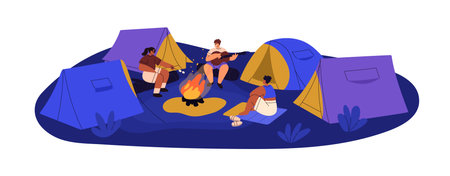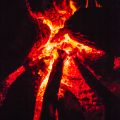1. Understanding the Local Wildlife
When planning a summer camping trip in bear country, its important to understand the types of wildlife you might encounter—especially bears. Knowing how these animals behave and where they live can help you stay safe and enjoy your outdoor adventure.
Common Bear Species in North America
In the United States, there are three main types of bears that campers may come across:
| Bear Species | Appearance | Habitat | Summer Behavior |
|---|---|---|---|
| Black Bear | Medium-sized, black or brown fur, straight face profile | Forests, mountains, near streams; widespread across the U.S. | Active during day and night; foraging for berries, insects, and human food |
| Grizzly Bear (Brown Bear) | Larger than black bears, brown fur with shoulder hump | Western U.S., especially Yellowstone and Glacier National Parks | Mainly active at dawn and dusk; feeding heavily to prepare for hibernation |
| Polar Bear | Large, white fur, long neck | Alaska’s coastal areas and Arctic regions | Less common for campers; active hunters around water and ice |
Understanding Bear Ecosystems
Bears thrive in ecosystems rich in food sources like fish, berries, nuts, and small mammals. During summer, these resources are abundant, making it a busy season for bear activity. Forests, riverbanks, mountain meadows, and even campgrounds can become part of their feeding routes.
Bears Are Not Always Aggressive—but They Are Curious
Bears generally avoid people but will investigate smells or sounds that catch their attention. This includes food left out at campsites or even scented toiletries. Learning about their natural curiosity helps campers take smarter precautions.
Other Wildlife You May Encounter
Apart from bears, campers might also see deer, raccoons, foxes, moose, or even wolves depending on the region. These animals can also pose risks if approached or fed by humans. Always observe wildlife from a distance and never feed them.
Understanding local wildlife is the first step toward a safe and respectful camping experience in bear country. With this knowledge in hand, youre better prepared to coexist safely with nature during your summer adventures.
2. Food Storage and Scent Management
When youre camping in bear country during the summer, one of the most important things you can do to stay safe is manage your food and any items with strong smells. Bears have an incredible sense of smell—much better than dogs—and they’re curious by nature. That means if they catch a whiff of something tasty at your campsite, they might come looking for it.
Bear-Proof Containers
Using bear-proof containers is one of the safest ways to store food. These hard-sided containers are specifically designed to keep bears out. Theyre usually required in many national parks and forest areas where bear activity is common.
Benefits of Bear-Proof Containers:
- Prevent bears from accessing your food
- Durable and weather-resistant
- Often approved by land management agencies like the National Park Service
Hanging Food Properly
If you don’t have a bear-proof container, the next best option is to hang your food correctly using the “bear hang” method. This involves suspending food bags between two trees or on a high branch where bears cant reach them.
Basic Bear Hang Guidelines:
| Requirement | Description |
|---|---|
| Height Above Ground | At least 10-15 feet off the ground |
| Distance From Tree Trunk | At least 4 feet away from the nearest trunk |
| Type of Rope | Strong nylon rope or paracord, about 50 feet long |
Scented Items to Store Safely
Bears aren’t just attracted to food—they’ll investigate anything that smells interesting. This includes toiletries, trash, sunscreen, and even clothes youve cooked in. Make sure these items are stored just like food: either in a bear-proof container or hung properly.
Items You Should Always Store Securely:
- All food and snacks (even sealed packages)
- Cooking utensils and cookware
- Toothpaste, deodorant, soap, sunscreen, bug spray
- Trash and used paper towels or napkins
- Pots and pans with food residue
Avoid Storing Food in Your Tent
No matter how tired you are after a long day of hiking, never bring food into your tent. Even crumbs or wrappers can attract wildlife. Keep all scented items at least 100 feet away from your sleeping area if possible.
Tip:
Create a designated cooking and eating area far from your tent to reduce scent transfer near where you sleep.
By being smart about how you store food and manage scents at your campsite, youre doing your part to keep both yourself and local wildlife safe.
![]()
3. Setting Up a Safe Campsite
When camping in bear country during the summer, how and where you set up your campsite can make a big difference in avoiding wildlife encounters. Bears have an incredible sense of smell and are naturally curious, so it’s important to take steps to keep your camp clean and organized. Heres how to create a safe environment for you and your group.
Choosing the Right Campsite Location
Start by picking a campsite that is away from known animal trails, berry patches, or water sources where bears may frequent. If youre in a designated campground, follow park guidelines and use established campsites. Avoid areas with fresh animal tracks or droppings.
Good Locations vs. Risky Locations
| Good Locations | Risky Locations |
|---|---|
| Open areas with good visibility | Dense brush or tall grass |
| At least 200 feet from water sources | Close to rivers or lakes |
| Away from animal signs like tracks or scat | Near game trails or berry bushes |
Maintaining a Clean Camp
Bears are attracted to smells—food, garbage, even toothpaste can draw them in. Keep your camp tidy and scent-free:
- Store all food in bear-proof containers or hang it at least 10 feet off the ground and 4 feet from tree trunks.
- Never leave trash or food scraps out; pack them out or dispose of them in designated bear-proof bins.
- Avoid cooking near your tent or sleeping area.
- Wash dishes immediately after meals and dump wastewater far from camp.
Tent and Cooking Area Placement
A common rule in bear country is the “Bear-muda Triangle.” This means setting up three separate areas for sleeping, cooking, and food storage—each about 100 feet apart in a triangle formation. This helps keep strong smells away from your sleeping area and reduces the chance of surprise wildlife visits.
Bear-muda Triangle Setup Example:
| Area | Description |
|---|---|
| Tent Site | Your sleeping area should be free of any food, scented items, or cooking gear. |
| Cooking Area | This is where you prepare meals; keep it clean and cook early to allow smells to fade before bedtime. |
| Food Storage | Use bear-proof containers or hang food properly; never store food in your tent. |
Quick Tips:
- Avoid wearing the same clothes you cooked in to bed—store them with your food if needed.
- If youre using scented bug spray or lotion, apply it away from your tent area.
- Teach kids about wildlife safety and make sure they follow the same rules as adults.
Taking time to choose your site carefully and keeping things tidy will go a long way toward staying safe during your summer camping trip in bear country.
4. Encounter Protocols and Bear Behavior
When camping in bear country during the summer, its essential to know how to react if you come face-to-face with a bear. Understanding the difference between defensive and predatory bear behavior can help keep you safe—and knowing how to use bear spray properly can be a lifesaver.
Defensive vs. Predatory Behavior
Bears usually want to avoid humans, but sometimes encounters happen. The way a bear behaves during an encounter can give you important clues about its intentions. Heres how to tell the difference:
| Behavior Type | Signs | What It Means |
|---|---|---|
| Defensive | Chuffing, jaw popping, huffing, swaying, bluff charges | The bear feels threatened—often protecting cubs or food nearby |
| Predatory | Quiet approach, focused stare, following you, no vocalizations | The bear may see you as prey—this is rare but very serious |
How to React During an Encounter
If the Bear Is Defensive:
- Stay calm. Speak softly and avoid sudden movements.
- Back away slowly—never run.
- Avoid eye contact; it may be seen as a threat.
- If the bear charges, it’s often a bluff—stand your ground.
- Use your bear spray if the bear gets within 30 feet (about 10 yards).
If the Bear Is Predatory:
- This is extremely rare but dangerous.
- Do not run—the bear may chase.
- Try to appear bigger: raise your arms and stand tall.
- Make loud noises: yell firmly, bang sticks or pots together.
- If attacked, fight back with everything you have—aim for the face and muzzle.
Proper Use of Bear Spray
Bear spray is your best defense in close-range encounters. But it only works if you know how to use it correctly:
- Carry it where its easy to reach, like on your hip or chest—not buried in your backpack.
- Remove the safety clip quickly when needed.
- Aim slightly downward in front of the charging bear, creating a cloud barrier.
- Spray in short bursts of 1–2 seconds. You don’t need to empty the can all at once unless necessary.
The key takeaway: stay alert, understand what the bear is trying to tell you with its behavior, and always be prepared with your bear spray. Knowledge and preparation are your best tools for staying safe in bear country.
5. Educating Campers and Following Regulations
When youre camping in bear country during the summer, its not just about having fun—its also about staying safe and respecting wildlife. One of the most important steps you can take is to make sure everyone in your group understands how to stay safe around wild animals, especially bears. Whether youre a seasoned camper or its your first trip, educating all campers is key to preventing dangerous encounters.
Teach Wildlife Safety Basics
Before setting up camp, take time to go over some basic safety tips with your group. This includes how to store food properly, what to do if you see a bear, and why keeping a clean campsite matters. Kids and new campers especially need clear, simple instructions they can remember.
Key Topics to Cover:
| Topic | Why It Matters |
|---|---|
| Food Storage | Bears have an excellent sense of smell; improper storage attracts them to campsites. |
| Safe Distances | Getting too close can provoke animals and lead to aggressive behavior. |
| What To Do If You See a Bear | Knowing whether to back away slowly or stand your ground could save lives. |
| Leave No Trace Principles | Keeps wildlife wild by minimizing human impact on their habitat. |
Stay Informed About Local Rules
Each park or forest area may have specific guidelines for camping in bear country. These rules are made for good reasons—to protect both people and wildlife. Make sure to check the official website or visitor center for up-to-date information before your trip. Some areas might require bear-proof containers, restrict campfire use, or have designated food storage areas.
Where to Find Regulation Info:
- National Park Service (nps.gov)
- U.S. Forest Service (fs.usda.gov)
- Local ranger stations or visitor centers
- Campsite bulletin boards or posted signs
Create a Group Safety Plan
If youre camping with family or friends, make a plan together. Assign roles like who will double-check food storage at night, who knows how to use bear spray (if allowed), and how everyone will communicate in case of an emergency. When everyone knows what to expect, theyre more likely to stay calm and act wisely if something unexpected happens.
Remember:
The more informed your group is, the safer everyone will be—including the animals that call bear country home.


